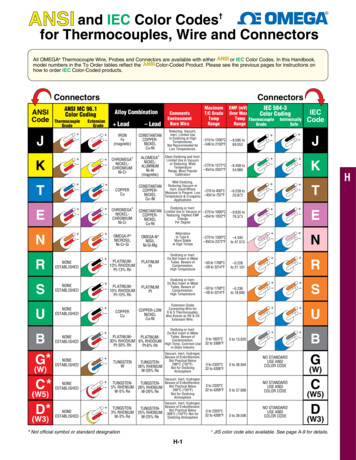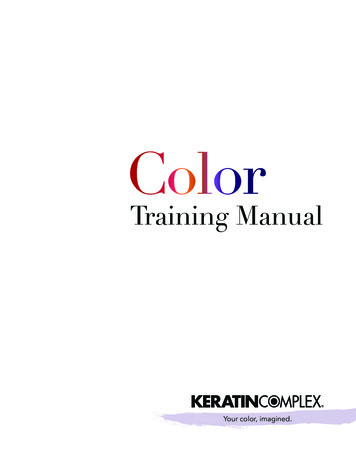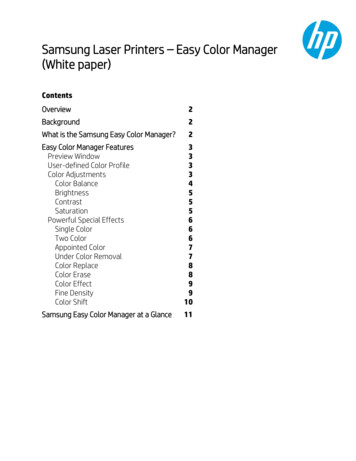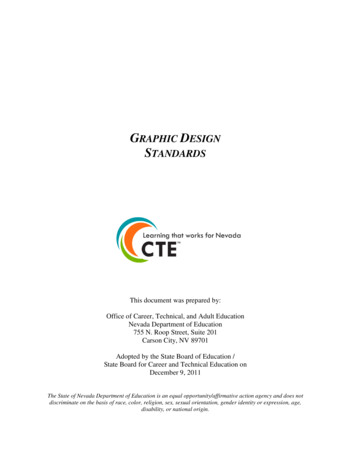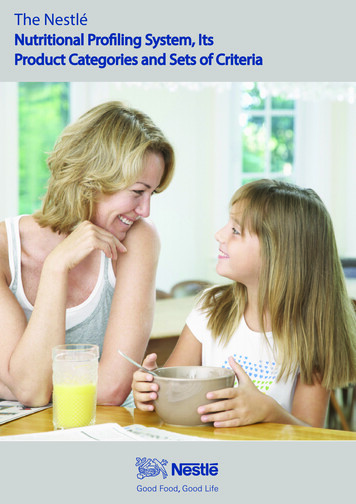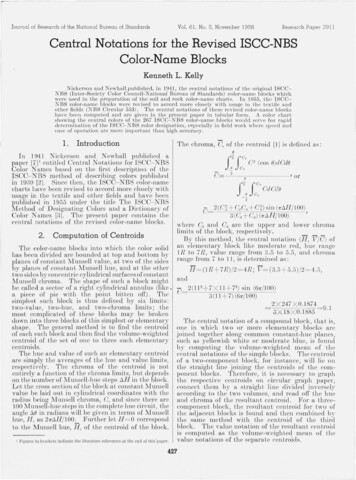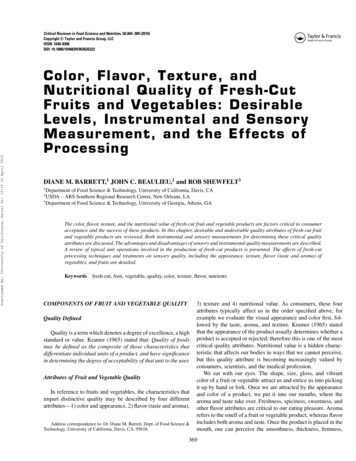
Transcription
Downloaded By: [University of California, Davis] At: 19:29 12 April 2010Critical Reviews in Food Science and Nutrition, 50:369–389 (2010)C Taylor and Francis Group, LLCCopyright ISSN: 1040-8398DOI: 10.1080/10408391003626322Color, Flavor, Texture, andNutritional Quality of Fresh-CutFruits and Vegetables: DesirableLevels, Instrumental and SensoryMeasurement, and the Effects ofProcessingDIANE M. BARRETT,1 JOHN C. BEAULIEU,2 and ROB SHEWFELT31Department of Food Science & Technology, University of California, Davis, CAUSDA – ARS Southern Regional Research Center, New Orleans, LA3Department of Food Science & Technology, University of Georgia, Athens, GA2The color, flavor, texture, and the nutritional value of fresh-cut fruit and vegetable products are factors critical to consumeracceptance and the success of these products. In this chapter, desirable and undesirable quality attributes of fresh-cut fruitand vegetable products are reviewed. Both instrumental and sensory measurements for determining these critical qualityattributes are discussed. The advantages and disadvantages of sensory and instrumental quality measurements are described.A review of typical unit operations involved in the production of fresh-cut products is presented. The effects of fresh-cutprocessing techniques and treatments on sensory quality, including the appearance, texture, flavor (taste and aroma) ofvegetables, and fruits are detailed.Keywordsfresh-cut, fruit, vegetable, quality, color, texture, flavor, nutrientsCOMPONENTS OF FRUIT AND VEGETABLE QUALITYQuality DefinedQuality is a term which denotes a degree of excellence, a highstandard or value. Kramer (1965) stated that: Quality of foodsmay be defined as the composite of those characteristics thatdifferentiate individual units of a product, and have significancein determining the degree of acceptability of that unit to the user.Attributes of Fruit and Vegetable QualityIn reference to fruits and vegetables, the characteristics thatimpart distinctive quality may be described by four differentattributes—1) color and appearance, 2) flavor (taste and aroma),Address correspondence to: Dr. Diane M. Barrett, Dept. of Food Science &Technology, University of California, Davis, CA, 95616.3) texture and 4) nutritional value. As consumers, these fourattributes typically affect us in the order specified above, forexample we evaluate the visual appearance and color first, followed by the taste, aroma, and texture. Kramer (1965) statedthat the appearance of the product usually determines whether aproduct is accepted or rejected; therefore this is one of the mostcritical quality attributes. Nutritional value is a hidden characteristic that affects our bodies in ways that we cannot perceive,but this quality attribute is becoming increasingly valued byconsumers, scientists, and the medical profession.We eat with our eyes. The shape, size, gloss, and vibrantcolor of a fruit or vegetable attract us and entice us into pickingit up by hand or fork. Once we are attracted by the appearanceand color of a product, we put it into our mouths, where thearoma and taste take over. Freshness, spiciness, sweetness, andother flavor attributes are critical to our eating pleasure. Aromarefers to the smell of a fruit or vegetable product, whereas flavorincludes both aroma and taste. Once the product is placed in themouth, one can perceive the smoothness, thickness, firmness,369
370D. M. BARRETT ET AL.hardness, or crispness of the fruit or vegetable material. Aschewing proceeds, the perception of textural quality changesand products generally become softer. Nutritional value is anextremely important quality component that is impossible to see,taste, or feel. Nutrients are critical for the growth and long-termdevelopment of our bodies, and include both “micro” nutrientsand “macro” nutrients. There are some associations betweentextural attributes, especially juiciness and flavor and betweenthe color and nutritional composition of fruits and vegetables.CHEMICAL AND PHYSICAL BASIS FOR FRUITAND VEGETABLE QUALITYDownloaded By: [University of California, Davis] At: 19:29 12 April 2010ColorColor is derived from the natural pigments in fruits and vegetables, many of which change as the plant proceeds throughmaturation and ripening. The primary pigments imparting colorquality are the fat soluble chlorophylls (green) and carotenoids(yellow, orange, and red) and the water soluble anthocyanins(red, blue), flavonoids (yellow), and betalains (red). In addition, enzymatic and non-enzymatic browning reactions may result in the formation of water soluble brown, gray, and blackcolored pigments. The enzymes involved in browning reactions include polyphenol oxidase, which catalyzes the oxidation of polyphenolic compounds, and phenylalanine ammonialyase, which catalyzes the synthesis of precursors to phenolicsubstrates.The chlorophylls are sensitive to heat and acid, but stable toalkali whereas their counterpart carotenoids are sensitive to lightand oxidation but relatively stable to heat. Carotenoids may bebleached by an enzyme called lipoxygenase, which catalyzesthe oxidation of lipid compounds. Anthocyanins are sensitive toboth pH and heat, while the flavonoids are sensitive to oxidationbut relatively stable to heat. Betalains are heat sensitive as well(Clydesdale and Francis, 1976).Appearance is determined by physical factors including thesize, the shape, the wholeness, the presence of defects (blemishes, bruises, spots, etc.), finish or gloss, and consistency. Sizeand shape may be influenced by cultivar, maturity, productioninputs, and the growing environment. It is important for fruitsand vegetables to be of uniform size and characteristic shape(Mitcham et al., 1996). Some consumers associate larger sizewith higher quality. The wholeness and absence of defects willbe affected by exposure to disease and insects during the growing period and the harvest and postharvest handling operations.Mechanical harvesting, for example, may incur more bruisesand cracks in fruits and vegetables than hand harvesting. Fruitand vegetable gloss are related to the ability of a surface to reflect light and freshly harvested products are often more glossy(Mitcham et al., 1996). Gloss is affected by moisture content,wax deposition on the surface, and handling practices postharvest. Consistency or smoothness may be used as an appearanceterm, but is typically applied to semi-solid products, where itindicates the product thickness.Flavor—Aroma and TasteFlavor has been defined (Anon, 1959) as: A mingled butunitary experience which includes sensations of taste, smell,and pressure, and often cutaneous sensations such as warmth,color, or mild pain. Flavor is typically described by aroma (odor)and taste. Aroma compounds are volatile—they are perceivedprimarily with the nose, while taste receptors exist in the mouthand are impacted when the food is chewed. While color andappearance may be the initial quality attributes that attract usto a fruit or vegetable product, the flavor may have the largestimpact on acceptability and desire to consume it again. Taste hasbeen divided into five primary tastes—sweet, sour, salty, bitter,and umami. Umami can be described as a taste associated withsalts of amino acids and nucleotides (Yamaguchi and Ninomiya,2000). Odors are much more diverse and difficult to classify, butan attempt by Henning (Gould, 1983) includes the following—spicy, flowery, fruity, resinous or balsamic, burnt, and foul.Stevens (1985) stated that it is possible to classify vegetablesinto two major groups, depending on their flavor characteristics.The first group of fruits and vegetables has a strong flavor thatcan be attributed to a single compound or group of related compounds. Bananas with isoamylacetate, onions with characteristicsulfide compounds, and celery, with distinctive phthalides areexamples of this group. The second group of fruits and vegetables includes those whose flavor is determined by a numberof volatiles, none of which conveys the specific characteristicaroma. Examples in this group include snap beans, muskmelons,and tomatoes.In the evaluation of fruit and vegetable flavor, it is importantto consider “off-flavors” as well as desirable ones. These offflavors may be produced through the action of enzymes suchas lipoxygenase or peroxidase, which form reactive free radicals and hydroperoxides that may catalyze the oxidation oflipid compounds. When these reactions occur, the result maybe the development of undesirable flavors described as rancid,cardboard, oxidized, or wet dog. However, there are instancesof enzyme-catalyzed reactions that result in desirable flavors.For example, hydroperoxide lyase catalyzes the production oftypical tomato flavors (Anthon and Barrett, 2003).TextureTextural parameters of fruits and vegetables are perceivedwith the sense of touch, either when the product is picked up byhand or placed in the mouth and chewed. In contrast to flavorattributes, these characteristics are fairly easily measured usinginstrumental methods. Most plant materials contain a significantamount of water and other liquid-soluble materials surroundedby a semi-permeable membrane and cell wall. The texture offruits and vegetables is derived from their turgor pressure, andthe composition of individual plant cell walls and the middlelamella “glue” that holds individual cells together. Cell wallsare composed of cellulose, hemicellulose, pectic substances,
Downloaded By: [University of California, Davis] At: 19:29 12 April 2010DESIRABLE AND UNDESIRABLE ASPECTS OF FRESH CUT VEGETABLES AND FRUITSproteins, and in the case of vegetables, lignin. Tomatoes are anexample of a fruit vegetable that is approximately 93–95% waterand 5–7% total solids, the latter comprised of roughly 80–90%soluble and 10–20% insoluble solids. The greatest contributorto the texture of tomato products are the insoluble solids, whichare derived from cell walls. The three-dimensional network ofplant cell walls is still unresolved, but is a topic of great interestto scientists in that to a large degree it dictates the perceptionof consistency, smoothness, juiciness etc. in fruit and vegetabletissues (Waldron et al., 2003).According to Bourne (1982) the textural properties of a foodare the “group of physical characteristics that arise from thestructural elements of the food, are sensed by the feeling oftouch, are related to the deformation, disintegration and flow ofthe food under a force, and are measured objectively by functions of mass, time, and distance.” The terms texture, rheology,consistency, and viscosity are often used interchangeably, despite the fact that they describe properties that are somewhatdifferent. In practice the term texture is used primarily withreference to solid or semi-solid foods; however, most fruits andvegetables are viscoelastic, implying that they exhibit combinedproperties of ideal liquids, which demonstrate only viscosity(flow), and ideal solids, which exhibit only elasticity (deformation).Nutritional ValueFruits and vegetables are a major source of both “macro”nutrients such as fiber and carbohydrates, and “micro” nutrientssuch as Vitamin C, B complex (thiamin, riboflavin, B6 , niacin,folate), A, E, minerals, and the lesser-studied polyphenolics,carotenoids, and glucosinolates. Nutrients may be classified aseither water or lipid soluble—meaning they dissolve in water or a lipid medium. Water soluble nutrients include VitaminC, B complex, polyphenolics, and glucosinolates. Fat solublenutrients include Vitamin A, E, and other carotenoids such aslycopene and β-carotene. Vitamin C is one of the most sensitivevitamins, being degraded relatively quickly by exposure to heat,light, and oxygen. For this reason it is often used as an indexof nutrient Department of Health and Human Services and thedegradation.The 2005 Dietary Guidelines for Americans, publishedjointly by the U.S.Department of Agriculture (http://www.health.gov/DietaryGuidelines/), suggest that both males and females increase their overall fruit and vegetable consumption to9 servings (about 4.5 cups) a day for a 2000 calorie diet. Thisis an increase of 50 to over 100 percent from current averageconsumption by U.S. consumers.USDA AND CALIFORNIA GRADE STANDARDSU.S. and California grade standards for fresh and processedfruits and vegetables have been summarized by Kader (2002).U.S. standards (USDA, 1998) are voluntary, except when they371are required by state and local regulations, industry marketingorders, or for export marketing. In addition to these federal gradestandards, the California Agricultural Code specifies mandatoryminimum standards for the quality of many fruits and vegetables(CDFA, 1983). Quality factors for fruits include the following—maturity, firmness, the uniformity of size and shape, the absenceof defects, skin and flesh color. Many of the same quality factorsare described for vegetables, with the addition of texture-relatedattributes such as turgidity, toughness, and tenderness.DESIRABLE AND UNDESIRABLE QUALITYATTRIBUTES IN FRESH-CUT FRUITS ANDVEGETABLESFresh-cut fruits and vegetables must have an attractive appearance, acceptable flavor, appropriate texture, and a positivenutritional image to attract initial and continued purchases byconsumers. Consumers may try a new product if attracted byits appearance, but they are unlikely to repurchase an item ifit fails to deliver on the promise of that appearance. Qualitycan be viewed from either a product or a consumer orientation(Shewfelt, 1999). A consumer orientation views the productthrough the sensory perspective of the consumer at the points ofpurchase and consumption (Shewfelt and Prussia, 1993). Consumers often buy the first time based on appearance, but repeatpurchases are driven by expected quality factors determined byflavor compounds and texture (Beaulieu, 2006a; Waldron et al.,2003).Color and AppearanceColor and appearance attract the consumer to a product andcan help in impulse purchases. At the point of purchase theconsumer uses appearance factors to provide an indication offreshness and flavor quality. External appearance of a wholefruit is used as an indicator of ripeness, although it can be amisleading one (Shewfelt, 2000a). Consumers have a preferredcolor for a specific item (Crisosto et al., 2003). Bananas aresupposed to be yellow with no brown spots, tomatoes red notorange, cherries red not yellow, and kiwifruit green-fleshed notyellow. With the exception of the outside of a few fruits likeBosc pears and kiwifruit, fresh fruits and vegetables should notbe brown. Gloss on the outside of whole fruits tends to be a desirable attribute for whole fruits. Fresh-cut fruits and vegetablesmust appear to be fresh, generally indicated by the brightness ofcolor and the absence of visual defects or drip. Sheen on the outside of most cut fruits is preferred to a dried appearance. Colorand appearance of the package can also influence the purchasedecision.Just as an attractive product can stimulate impulse purchases,an unattractive appearance can repel a consumer away from anintended purchase. Colors that are not appropriate for the item,indicative of loss of freshness or suggestive of a lack of ripeness,
Downloaded By: [University of California, Davis] At: 19:29 12 April 2010372D. M. BARRETT ET AL.can turn away willing consumers. Some consumers tend to rejectsweet (yellow with brown spots) bananas, nutritious, high βcarotene (yellow and orange) tomatoes, and flavorful Ranier(yellow with red blush) cherries due to unexpected coloration.Wilting, browning, dull colors, and drip are all indicators of lossof freshness in fresh-cut vegetables (Shewfelt, 1993).White blush in cut carrots is a quality defect (Emmambuxand Minnaar, 2003). Russet (brown) spotting and brown stain(Kader and Saltveit, 2003) (two separate disorders) are undesirable visual defects in lettuce. Visible wilting in lettuce andcelery and shriveling in fruits reduce consumer acceptability.Yellowing in green vegetables due to loss of chlorophyll is unacceptable (Shewfelt, 2003). Less intensity of color indicateslack of ripeness in fresh-cut fruits. Browning is a serious quality defect in fresh-cut fruits. Many purchasers of organic fruitsand vegetables may actually favor items with visual defects asevidence of authenticity.FlavorFlavor of fresh-cut fruits is more important than for fresh-cutvegetables due to the way the products are consumed. Fresh-cutvegetables tend to be consumed as components of salads or sandwiches. Since fresh-cut fruits are more likely to be consumedwithout other ingredients, they must be sweet without the presence of off-flavors. Since sweetness increases with ripening andripe fruits deteriorate more rapidly, most fruits are harvestedbefore full sweetness has been achieved. Sweetness does notincrease in coated, cut cantaloupe during storage (Eswaranandam et al., 2007), and it is unlikely that significant increases insweetness will occur in other fresh-cut fruits after packaging.Development of more intense aroma has been achieved by feeding precursors into the atmosphere of strawberry tissue culturesand fruit (Zabetakis and Holden, 1997), but this technique is notbeing used commercially.Bitterness is an undesirable taste found in some fresh-cutvegetables such as salad greens (Dinehart et al., 2006). WhenCruciferae cells are ruptured, glucosinolates undergo enzymatichydrolysis with the endogenous myrosinase enzymes, releasingthiocyanates, isothiocyanates (Wattenberg, 1978), sulphate, andglucose (Ju et al., 1982). Processing and packaging precautions must be taken to ensure that off-odors and off-flavors donot jeopardize the marketability of shredded Crucifer products.Sourness is an indication of the use of immature fresh-cut fruitssuch as may occur in the case of apples (Harker et al., 2003).fruits and vegetables, textural defects and the interaction of flavor and texture are more likely to cause rejection of a freshproduct (Harker et al., 2003). Consumer and panel testing indicates that they are actually more sensitive to small differencesin texture than flavor (Beaulieu et al., 2004; Shewfelt, 1999).Undesirable textural attributes are the opposite of the desirableones. Wilted lettuce, limp carrots or celery, and flaccid radish areunacceptable as are crunchy or mushy cantaloupes and peaches.Soggy or mealy apples are also likely to be rejected.Nutritional ValueConsumers expect fresh fruits and vegetables to be goodsources of dietary fiber and many vitamins and minerals. Unfortunately they have no way of distinguishing between individualproducts that have high versus low concentrations of phytonutrients. Many factors contribute to the nutrient content of a fruitor vegetable available for sale including genetics, growing conditions (light, temperature, etc.) and production practices (fertilization, irrigation, etc.), maturity at harvest, and postharvesthandling conditions. During storage little change occurs in dietary fiber and mineral content, but the vitamins are lost. Cuttingstimulates ethylene production which in turn increases respiration and senescence leading to even more rapid loss of certainvitamins. Vitamin C is the vitamin that usually degrades mostrapidly and can be used as an index of freshness. Vitamin C is unstable in many vegetables such as asparagus (Saito et al., 2000)and jalapeno pepper (Howard and Hernandez-Brenes, 1997).Slight vitamin C losses in stored fresh-cut cantaloupe were alsoreported recently (Beaulieu and Lea, 2007; Gil et al., 2006).ConvenienceThe attribute that drives fresh-cut products is convenience(Raegert et al., 2004). Consumers purchase cut fruits and vegetables for consumption right out of the package. The formerInternational Fresh-Cut Produce Association defined fresh-cutproduce as trimmed, peeled, washed, and cut into 100% usableproduct that is subsequently bagged or prepackaged to offerconsumers high nutrition, convenience, and value while stillmaintaining freshness (Beaulieu and Gorny, 2004). These products should be clean with no evidence of soil or odor of chlorineor other sanitizers. All pieces in the package should be edibleand require no further preparation steps other than transfer frompackage to plate.TextureConsumers have clear expectations for the texture of freshcut vegetables and fruits. Salad vegetables like lettuce, carrot,celery, and radish should be crisp. Soft fruits such as cantaloupeand peach should yield to chewing without being mushy. Otherfruits like apples should be crisp and crunchy. While consumersgenerally cite flavor as the most important quality attribute forADVANTAGES AND DISADVANTAGES OF SENSORYAND INSTRUMENTAL QUALITY MEASUREMENTSThe quality of fresh-cut fruits and vegetables can be measuredby sensory and instrumental methods. In general, sensory methods are more useful in developing new products and determining
Downloaded By: [University of California, Davis] At: 19:29 12 April 2010DESIRABLE AND UNDESIRABLE ASPECTS OF FRESH CUT VEGETABLES AND FRUITSproduct standards while instrumental methods are superior inmeasuring quality on a routine basis (Shewfelt, 1993).Sensory evaluation of food products is divided into twocomponents—analytical and affective measurements. Analytical measurements can be used to detect differences (differencetests) or to describe the product (descriptive analysis). Analytical sensory tests are usually conducted by small panels withsome training of the panelists. Affective measurements determine preference (which samples are preferred over others) andusually require large numbers of naı̈ve panelists (Institute ofFood Technologists, 1981).There are many advantages to sensory methods of qualitymeasurement. Since human perception is involved in sensorytesting, quality attributes are clearly defined in terms that arerelevant to consumer acceptability. Affective consumer tests arethe only way to determine what consumers like and what they donot like. Sensory descriptive panels can be used to identify smalldifferences in quality between similar samples. Well-trained descriptive panels are able to screen out competing attributes tofocus on an attribute of specific interest. Among the disadvantages of sensory methods, analytical and affective (consumer)sensory panels are the complex logistics. Descriptive panels require extensive training and can produce highly variable resultsif training is inadequate. The results from consumer panels tendto be highly variable. In addition, it is difficult to relate sensorydata to chemical composition in an effort to determine mechanistic reasons for differences in samples.Instrumental measurements encompass a wide range of techniques used to determine color, appearance, flavor, texture, andnutritional quality. Instrumental techniques are advantageous inthat they tend to provide accurate and precise results. The resultsof instrumental tests can generally be related directly to chemical and physical properties allowing the investigator to gain amechanistic understanding of observed differences. Instrumentstend to be more sensitive to small differences between samplesand may be able to detect trends in quality loss before they canbe detected by humans (Thai et al., 1990; Brosnan and Sun,2004). Instruments do not object to working at nights and weekends and can produce large amounts of data without complaint,making them excellent monitors in Quality Control operations.A primary disadvantage of instrumental testing is that manyinstrumental measurements have little relevance to consumeracceptability and thus should never be used to define qualityattributes for a specific product. In other words “it is better tomeasure what is really important than to believe something isimportant because you measure it really well.” (Shewfelt andPhillips, 1996).Sensory and instrumental tests are best used in conjunctionwith each other using the most appropriate test to meet thedesired objective. Affective testing helps determine which attributes are important to the consumer. Difference tests can determine if individual units are noticeably different, and sensorydescriptive analysis can identify the attributes that cause thedifferences. When carefully coordinated, the sensory tests canbe very effective in developing new products and establishing373quality standards. Instrumental tests are more useful in measuring standards in a quality control setting and in determining themechanistic reason for differences.SENSORY METHODS OF QUALITY MEASUREMENTIn-depth descriptions of sensory techniques are available formeasuring food quality in general (Institute of Food Technologists, 1981; Meilgaard et al., 1999; Lawless and Heymann,1998) and fruit and vegetable quality specifically (Shewfelt,1993). As described above, sensory evaluation is divided intotwo components—analytical and affective measurements. Twotypes of analytical tests are difference tests and descriptiveanalysis.Analytical MeasurementsDifference tests are conducted to determine if there is a detectable difference between two samples, for example two different varieties of cut cantaloupe. The most common differencetest is the triangle test. Each panelist is given three samples, twoare similar and one is different. The panelist is asked to identifythe different sample. Panelists in this type of test are not trained.At least 30 panelists are required for difference tests, and 50 ormore panelists are preferred. Samples should be presented as theitem is normally consumed and presented in a controlled environment. The order of sample presentation must be randomized.Precautions in running a difference test include making sure thatthere are no unintentional clues to signal the difference. For example, if the test is to determine possible differences in flavor,steps must be taken to make sure that differences in color, size,shape, and texture are not providing clues to the panelists. Also,investigators must ensure that all samples are at a similar stageof ripeness.Descriptive analysis involves the development of a lexiconand panel training (Meilgaard et al., 1999). A lexicon is the listof terms used as descriptors and a precise definition of theseterms. If the testing material is an item like tomatoes that hasbeen well characterized (Krumbein et al., 2004), terms and definitions are selected from previous studies. For other items suchas eggplant (Sesena et al., 2002) the descriptive panel evaluates an extensive range of varieties for that item to developterms that describe the range of products to be tested. Lexiconscan be extensive with up to 50 descriptors of minimalist withas few as 5 descriptors. Upon selection or determination of alexicon, the panel must go through training and calibration toensure that the panel results are accurate and precise. Training can be as extensive as two hours a week for six months toless intensive sessions over a one-to-two week period. Panelistswho are outliers undergo additional training or are dismissed.Upon the completion of training, the evaluation of the samplesis conducted in partitioned booths using one of several evaluation methods including Spectrum (Meilgaard et al., 1999)
Downloaded By: [University of California, Davis] At: 19:29 12 April 2010374D. M. BARRETT ET AL.and Quantitative Descriptive Analysis (QDA; Stone and Sidel,2004). The primary differences between the two techniques arethat Spectrum uses standards for the descriptors and involvesmore extensive training than QDA. For a discussion of the differences in analysis and data interpretation, see Harker, et al.(2003).A more limited approach to descriptive analysis is the useof an experienced panel. Experienced panelists have had sometraining on similar items in the past, but the panel director usually selects a limited number of descriptors for evaluation. Thepanel is convened with a few training sessions primarily to ensure that the panelists are familiar with the terminology. Expertevaluations may be most appropriate when visual evaluation ofa large number of samples is needed over the life of the product (Shewfelt, 1993). Usually two to five judges evaluate thesamples independently of each other to prevent bias.Affective MeasurementsAffective testing can take many forms, but the most widelyused techniques are the focus group, surveys, and the consumerpreference test. Focus groups involve group interviews of 8–12participants of current and potential consumers of the item(s)being evaluated (Krueger and Casey, 2000). A focus group is anexcellent way to determine the range of opinions about a fruit ora vegetable, but the panel size is too small to obtain quantitativerelationships. Focus groups are usually repeated for a given topicuntil little or no additional qualitative information is collected.Focus groups are also very effective in selecting questions fora survey. At least 50, and preferably over 200, participants areneeded for a survey to be useful. It is important to collect basicdemographic information in a survey and frequency of purchaseor consumption of the item(s) being studied. The results shouldbe partitioned by categories of interest.Consumer preference tests (Table 1) provide ground truth toany study as what consumers indicate in a focus group or surveyquestionnaire may not be verified when presented with actualsamples. For example, many consumers indicate that items canbe too sweet, but the sweetest sample is consistently rated as themost preferred (Civille, 1991). Once again, a minimum of 50participants is required with over 200 preferred. When a smallnumber of treatments ( 5) are being tested, every participantTable 1Scales used in the evaluation of food qualityHedonic9 – Like extremely8 – Like very much7 – Like moderately6 – Like slightly5 – Neither like or dislike4 – Dislike slightly3 – Dislike moderately2 – Dislike very much1 – Dislike extremelyPurchase5 – Definitely would4 – Pr
aroma and taste take over. Freshness, spiciness, sweetness, and other flavor attributes are critical to our eating pleasure. Aroma refers to the smell of a fruit or vegetable product, whereas flavor includes both aroma and taste. Once the product is placed in the mouth,
